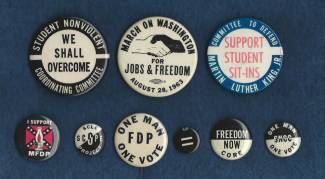Collection Name
About
The August 28, 1963 March on Washington was estimated at 250,000 people. This march put the struggle for civil rights at the top of the American agenda and helped create the demand for passage of the civil rights bill which had already been introduced. This 1963 March on the Federal Mall is remembered for the famous "I Have a Dream" speech of Dr. Martin Luther King, Jr. (1929-1968). John Lewis, Chairman of the Student Non-violent Coordinating Committee, and now a United States Congressman, also spoke, as did Philip Randolph (1889-1979), who had founded the first black labor union, the Brotherhood of Sleeping Car Porters in 1925. Anniversary marches were held on August 27, 1983 with about 250,000 people in attendance, and again on August 23, 2003 with about 75,000 participants.
The Student Nonviolent Coordinating Committee (SNCC) was founded in 1960. Its role was to provide young blacks an opportunity to participate in the civil rights struggle and movement. SNCC's major purpose was to register blacks to vote in the South. Under the leadership of Stokely Carmichael (1941-1998) in 1966-1967, it would evolve into a more radical organization.
The Congress of Racial Equality (CORE) was founded in 1942. It was CORE which organized the Freedom Rides of 1961. With the Supreme Court ruling in 1960 that interstate buses and terminals were to be integrated, CORE members boarded Greyhound Buses from Washington, D.C. to New Orleans, Louisiana to test the new law. Over 1000 Freedom Riders, both black and white volunteers, traveled throughout the South attempting to peacefully confront and protest via sit-ins and other non-violent actions the segregation and unequal accommodations in the South, primarily at restaurants, lunch counters, restrooms, and motels.
The Mississippi Freedom Democratic Party (MFDP) was founded in 1964 as an attempt to get black Mississippians active in the Deep South's Democratic Party, which at that time did not support Civil Rights. Led by Fannie Lou Hammer (1917-1977), the MFDP is remembered for when its representatives appeared at the 1964 Democratic National Convention in Atlantic City to contest the all-white Mississippi delegation as not being representative of all Mississippians.
In 1910 the Committee on Urban Conditions Among Negroes was founded in New York City. Quite simply, its purpose was to fight against the racial discrimination against blacks that was prevalent throughout the United States. Upon merging with several other organizations the group eventually came to be known as The National Urban League in 1920 with the purpose of working toward the equality and economic self-reliance of the country's black population. The National Urban League exists today and is characterized by its "equal" sign logo.
In 1957, Martin Luther King, Jr., Ralph Abernathy, and others founded and organized the Southern Christian Leadership Council (SCLC), which exists to this day. Its initial purpose was to work with and establish local organizations, primarily in the South, to work for equal rights for blacks. The SCLC Scope Project (which stood for Summer Community Organization and Political Education) involved over 500 college students during the summer of 1965 in the registration of voters in five southern states. Organized by the Reverends Martin Luther King, Jr. and Hosea L. Williams, over 49,000 new voters were registered.
In October 1960, Martin Luther King, Jr. was arrested and jailed in Georgia after joining some students at a sit-in to protest segregation at an Atlanta department store lunch counter. The charge was trespassing. Earlier that year, in May, he was indicted and tried for perjury in Montgomery, Alabama. He was found not guilty by a jury of all white men. We are pretty sure that the "Committee to defend Martin Luther King" was in place for the perjury trial, but because of the "Support Student Sit-Ins" reference on the button, we note both of the above incidents.
The One Man-One Vote FDP button was worn by members of the Mississippi Freedom Democratic Party in their efforts to register African-American voters in the mid-1960's.
Buttons from the collection of Albert and Angela Feldstein.
Text from over forty years of notes, newspaper and magazine clippings, flyers, and other sources associated with the collecting of buttons and used in the research of the 2003 political history poster entitled, "Buttons of the Cause, 1960-2003: The Events, The People, The Organizations, The Issues".
